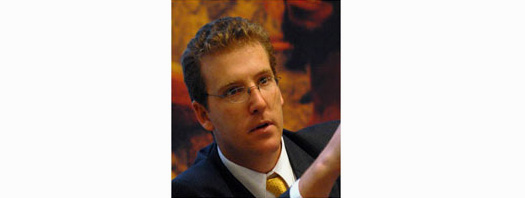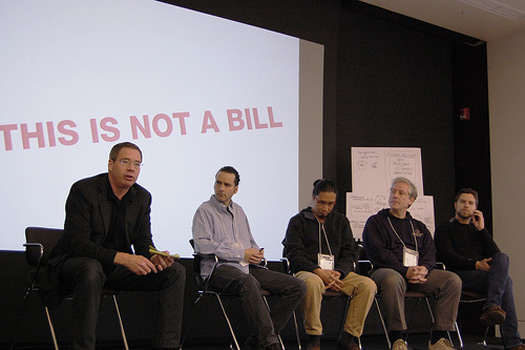
August 3, 2010
Next: Innovation Tools & Trends Rockefeller Foundation’s Push Toward Design and Innovation

Recently, I wrote a story about the Aspen Design Summit, a small event at which big name designers and philanthropists got together to talk about ways to apply the techniques of design thinking to social problems such as poverty, hunger or healthcare. As a part of my reporting, I spoke to Antony Bugg-Levine, managing director of the Rockefeller Foundation, which in 2008 gave a $1.5 million grant to the Winterhouse Institute, the design group organizing the event.
Bugg-Levine leads the Accelerating Innovation for Development initiative that Rockefeller launched in late 2007, and he had a lot to say about the world in which we live, about the place of design within innovation, and about the promise of private sector influence on the nonprofit world. His words didn’t fit into the final piece, but what he said has really resonated with me in the weeks since we published, so here (and after the jump) is an edited transcript of our conversation.
Helen Walters:
What’s Rockefeller’s interest in supporting design-driven innovation?
Antony Bugg-Levine:
For us as a foundation it’s part of an evaluation of how to be an effective force in the 21st century. The complexity of the problems we address necessitate new approaches. Frankly the problems the world faces are accelerating faster than we can solve with traditional approaches. So we look for partners whose approach will allow us to harness creativity. Clearly the design community and people engaged in innovation have a lot to say.
What’s the focus and format of the Accelerating Innovation for Development initiative?
It’s an initiative with two main components. One is a set of grants which seek to demonstrate that innovation processes can be applied to solve social problems. The second is to increase the application of those processes. So we’re working with (innovation consultancies such as) IDEO, Innocentive and others to enable them to work on social problems so we can show this [concept] is powerful. Then we’re looking to increase take-up in three areas: crowdsourcing; user-driven innovation and human-centered design. The Aspen conference fits into the human-centered design piece.
In Aspen, there was talk among the attendees of the challenges of for-profit consultancies working on philanthropic projects. There’s a lot of enthusiasm for social initiatives, but a less than clear business model. What’s the solution?
The business models of most design firms were built to serve commercial clients, so it’s difficult for them to work on the issues of poor people who can’t afford to pay on any kind of scale. There’s no lack of enthusiasm and excitement for working in this area, but it’s forced to be occasional pro bono work rather than there being a systematic approach. Then you have top private sector firms interfacing with nonprofits or social enterprise firms and there’s a square peg in a round hole problem. We need to build a better way for them to interface. So our first meeting in June 2008 basically tackled the question of what it would take for companies to develop business models that wold allow them to apply skills and expertise to the problems of poor people more often, more effectively and more expansively. Aspen is a part of building a process to allow us to implement some of these ideas.
Where has the discussion taken you so far?
We’re talking to leading design and innovation firms more generally about developing structural solutions, rather than the short term solution of a private foundation providing subsidies so they can work with NGOs who can’t pay full fees. That’s not scalable or sustainable. I think in 2010 you should hear two announcements, and firms will be innovating their business models in two directions. Some firms are interested in creating NGO spin offs, while a second route is to think about disruptive innovations to their own cost structures. If you’re in a U.S. office trying to design for an organization reaching 100 million poor people in India, the costs are prohibitive and the answer is not as effective. I think maybe more firms will set up dedicated offices in emerging markets to addressing the problems of development.
How is Rockefeller embedded in the emerging markets themselves?
The premise of our initiative is to see the application of cutting edge innovation processes applied to solving poor people’s problems. The leading incumbent firms will figure out how to serve markets, but new firms starting in these markets will end up raising their ability to solve problems and will stand alongside the IDEOs of the world. We’re meeting with and learning about the most promising start ups, which are often younger, smaller and focused on a particular marketplace.
I’ll be honest. There were moments in Aspen where I was somewhat concerned that the Institute, where the event was held, was doubling as an ivory tower in which we could come up with well-meaning but unlikely solutions. Is that a problem you face, and how do you combat it?
In the 20th century, philanthropy as a field could do fantastic work when its model was to gather experts in a field and take visionary ideas and work at scale in a largely top down way. The Rockefeller Foundation had some profound, inspiring success with this model. But those approaches don’t work in the 21st century. The world’s problems are more complex and necessitate collaboration. Expertise is increasingly diffuse throughout the world. We couldn’t agree more that solutions cooked up in ivory towers by experts disconnected from the problems of the people they seek to solve will not work. That’s why we focus on user-driven innovation and crowdsourcing as the defining tools of 21st century philanthropy. We’ve also looked at positive deviants (see also this recent post about this great concept) and we’ve also worked with Ashoka’s Changemakers.
The thread is our attempt to harness those tools that allow us to access the wisdom of the people whose lives we ultimately seek to support. It’s trying to put real process and disicipline behind the rhetoric of being inclusive. One thing we learned, there are substantial structural barriers to manifesting and benefiting from the potential inherent in the ideas behind crowdsourcing and human driven design.
How are you measuring the impact and effect of your work?
Success for us is not a few interesting projects done by Rockefeller and its grantees, but insights that will inform how the philanthropic sector takes advantage of these processes. Success isn’t anecdotal examples that a design process can result in a better product, on a one off basis, after a major infusion subsidy from the Rockefeller Foundation. We see success as the improved application of principles of design throughout not only the philanthropic sector but also through the very complex universe of individuals and instirutions looking to solve increasingly complex problems.
This essay was published on Bloomberg Businessweek on January 5, 2010 and is reprinted here with the publication’s kind permission.
Observed
View all
Observed
By Helen Walters
Related Posts

Ernest Beck|Event-Aspen
Sustainable Health Enterprises Wins Prestigious Curry Stone Design Prize

Arts + Culture
Aspen Editors|Event-Aspen
Aspen Design Summit: Update 09.25.10

Helen Walters|Event-Aspen
Inside the Design Thinking Process

Ernest Beck|Event-Aspen
Aspen Design Summit: CDC and Healthy Aging: “5over50” Funding Proposal
Recent Posts
“Dear mother, I made us a seat”: a Mother’s Day tribute to the women of Iran A quieter place: Sound designer Eddie Gandelman on composing a future that allows us to hear ourselves think It’s Not Easy Bein’ Green: ‘Wicked’ spells for struggle and solidarity Making Space: Jon M. Chu on Designing Your Own PathRelated Posts

Ernest Beck|Event-Aspen
Sustainable Health Enterprises Wins Prestigious Curry Stone Design Prize

Arts + Culture
Aspen Editors|Event-Aspen
Aspen Design Summit: Update 09.25.10

Helen Walters|Event-Aspen
Inside the Design Thinking Process

Ernest Beck|Event-Aspen

